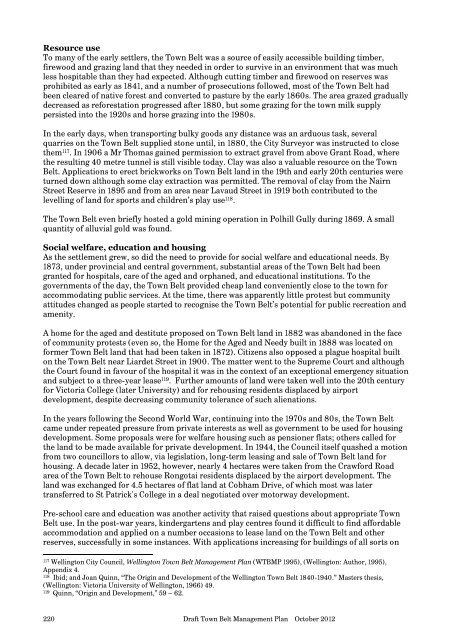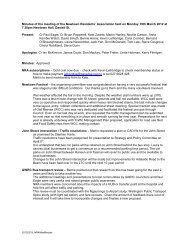Draft Town Belt Management Plan - Wellington City Council
Draft Town Belt Management Plan - Wellington City Council
Draft Town Belt Management Plan - Wellington City Council
You also want an ePaper? Increase the reach of your titles
YUMPU automatically turns print PDFs into web optimized ePapers that Google loves.
Resource use<br />
To many of the early settlers, the <strong>Town</strong> <strong>Belt</strong> was a source of easily accessible building timber,<br />
firewood and grazing land that they needed in order to survive in an environment that was much<br />
less hospitable than they had expected. Although cutting timber and firewood on reserves was<br />
prohibited as early as 1841, and a number of prosecutions followed, most of the <strong>Town</strong> <strong>Belt</strong> had<br />
been cleared of native forest and converted to pasture by the early 1860s. The area grazed gradually<br />
decreased as reforestation progressed after 1880, but some grazing for the town milk supply<br />
persisted into the 1920s and horse grazing into the 1980s.<br />
In the early days, when transporting bulky goods any distance was an arduous task, several<br />
quarries on the <strong>Town</strong> <strong>Belt</strong> supplied stone until, in 1880, the <strong>City</strong> Surveyor was instructed to close<br />
them 117 . In 1906 a Mr Thomas gained permission to extract gravel from above Grant Road, where<br />
the resulting 40 metre tunnel is still visible today. Clay was also a valuable resource on the <strong>Town</strong><br />
<strong>Belt</strong>. Applications to erect brickworks on <strong>Town</strong> <strong>Belt</strong> land in the 19th and early 20th centuries were<br />
turned down although some clay extraction was permitted. The removal of clay from the Nairn<br />
Street Reserve in 1895 and from an area near Lavaud Street in 1919 both contributed to the<br />
levelling of land for sports and children’s play use 118 .<br />
The <strong>Town</strong> <strong>Belt</strong> even briefly hosted a gold mining operation in Polhill Gully during 1869. A small<br />
quantity of alluvial gold was found.<br />
Social welfare, education and housing<br />
As the settlement grew, so did the need to provide for social welfare and educational needs. By<br />
1873, under provincial and central government, substantial areas of the <strong>Town</strong> <strong>Belt</strong> had been<br />
granted for hospitals, care of the aged and orphaned, and educational institutions. To the<br />
governments of the day, the <strong>Town</strong> <strong>Belt</strong> provided cheap land conveniently close to the town for<br />
accommodating public services. At the time, there was apparently little protest but community<br />
attitudes changed as people started to recognise the <strong>Town</strong> <strong>Belt</strong>’s potential for public recreation and<br />
amenity.<br />
A home for the aged and destitute proposed on <strong>Town</strong> <strong>Belt</strong> land in 1882 was abandoned in the face<br />
of community protests (even so, the Home for the Aged and Needy built in 1888 was located on<br />
former <strong>Town</strong> <strong>Belt</strong> land that had been taken in 1872). Citizens also opposed a plague hospital built<br />
on the <strong>Town</strong> <strong>Belt</strong> near Liardet Street in 1900. The matter went to the Supreme Court and although<br />
the Court found in favour of the hospital it was in the context of an exceptional emergency situation<br />
and subject to a three-year lease 119 . Further amounts of land were taken well into the 20th century<br />
for Victoria College (later University) and for rehousing residents displaced by airport<br />
development, despite decreasing community tolerance of such alienations.<br />
In the years following the Second World War, continuing into the 1970s and 80s, the <strong>Town</strong> <strong>Belt</strong><br />
came under repeated pressure from private interests as well as government to be used for housing<br />
development. Some proposals were for welfare housing such as pensioner flats; others called for<br />
the land to be made available for private development. In 1944, the <strong>Council</strong> itself quashed a motion<br />
from two councillors to allow, via legislation, long-term leasing and sale of <strong>Town</strong> <strong>Belt</strong> land for<br />
housing. A decade later in 1952, however, nearly 4 hectares were taken from the Crawford Road<br />
area of the <strong>Town</strong> <strong>Belt</strong> to rehouse Rongotai residents displaced by the airport development. The<br />
land was exchanged for 4.5 hectares of flat land at Cobham Drive, of which most was later<br />
transferred to St Patrick's College in a deal negotiated over motorway development.<br />
Pre-school care and education was another activity that raised questions about appropriate <strong>Town</strong><br />
<strong>Belt</strong> use. In the post-war years, kindergartens and play centres found it difficult to find affordable<br />
accommodation and applied on a number occasions to lease land on the <strong>Town</strong> <strong>Belt</strong> and other<br />
reserves, successfully in some instances. With applications increasing for buildings of all sorts on<br />
117 <strong>Wellington</strong> <strong>City</strong> <strong>Council</strong>, <strong>Wellington</strong> <strong>Town</strong> <strong>Belt</strong> <strong>Management</strong> <strong>Plan</strong> (WTBMP 1995), (<strong>Wellington</strong>: Author, 1995),<br />
Appendix 4.<br />
118 Ibid; and Joan Quinn, “The Origin and Development of the <strong>Wellington</strong> <strong>Town</strong> <strong>Belt</strong> 1840-1940.” Masters thesis,<br />
(<strong>Wellington</strong>: Victoria University of <strong>Wellington</strong>, 1966) 49.<br />
119 Quinn, “Origin and Development,” 59 – 62.<br />
220<br />
<strong>Draft</strong> <strong>Town</strong> <strong>Belt</strong> <strong>Management</strong> <strong>Plan</strong> October 2012





